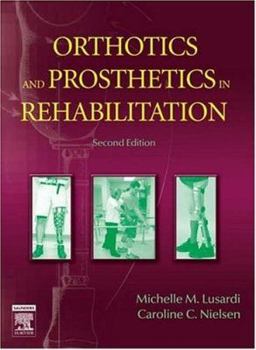Orthotics and Prosthetics in Rehabilitation
Select Format
Select Condition 
Book Overview
Rationale:
In the clinical science segment of most physical therapy programs there is a course devoted to orthotics and prosthetics. Lusardi is the most comprehensive textbook for physical therapy students devoted to this topic. Lusardi was originally published by Butterworth in June 2000. The purpose was to provide a text that was not as technical as the atlases on the market, but provided more clinically relevant information for the physical therapy student. In the second edition, published in June of 2006, the book became more student-friendly by referencing The Guide to Physical Therapist Practice2E and incorporated additional case studies.
We are proposing a 3rd edition of this text. The current edition has sold almost 5400 units less than 3 years. The 1st edition sold 5900 units in 6 years, so we're seeing an increase in sales for this book with the current edition. We intend to maintain the approach of the text while adding an EVOLVE site that will include features such as an image collection videos, PowerPoints, references from the text linked with Medline abstracts, and case studies to appeal to the student learner and instructors of today. New topics will cover multicultural issues, wound healing, advanced rehabilitation, wounded soldiers, and sports.
A new co-author is being brought in as Caroline Nielsen is unable to participate at the full level of an editor. Millee Jorge will bring a fresh, multi-cultural approach to the new edition.
Book Description:
Orthotics and Prosthetics in Rehabilitation 3E will continue to cover basic information about orthotic/prosthetic prescription and fabrication to give students a foundation for gait assessment both pre and post intervention. It incorporates principles of motor control and motor learning into orthotic and prosthetic intervention. The section on orthotics builds on general principles by introducing the various kinds of body orthotics. There is a separate chapter covering each type of orthotic followed by clinical applications for typical and special populations.
The section on prosthetics provides an overview of the epidemiology of amputation and the criteria the PT needs in order to determine the necessity for prosthetic limbs. Guidelines for pre-prosthetic training programs are included. Case studies show the application of the various situations leading to amputation. Updates will reflect the new enhancements and technology since the last edition.
Five new chapters will be added covering multicultural issues, wound healing, advanced rehabilitation, wounded soldiers, and sports, all bringing new information to the book, making it more of an invaluable resource.
Includes guidelines for pre-prosthetic training programsPresents case vignettes as models of evidence-based practice and clinical decision makingUses a multidisciplinary approach to demonstrate how physical therapists can best work with the rest of the health care teamReferences the Guide to Physical Therapist Practice, 2nd Edition to keep readers up to date with the recognized standard in the fieldCoverage of the latest equipment and technology helps readers understand current options for their patientsAdditional case studies show the application of various situations leading to amputationNew information on the WHO disablement model, showing how it applies to orthotics and prostheticsNew chapters on orthotics in the management of neuromuscular impairment, orthotics in the management of musculoskeletal impairment, adaptive seating (unique ), and advanced training and athletics for persons with lower extremity amputationRelated Subjects
Allied Health Professions Allied Health Services Clinical Education & Reference General General Surgery Internal Medicine Medical Medical Books Medicine Orthopedics Otolaryngology Otorhinolaryngology Physical Medicine & Rehabilitation Physical Therapy Prosthesis Special Topics Surgery






